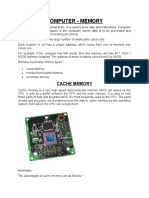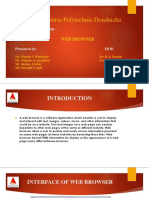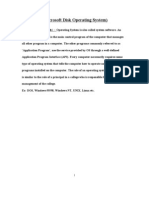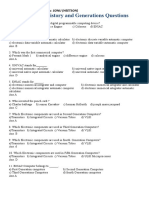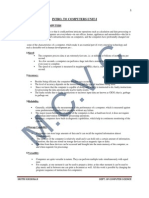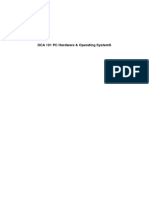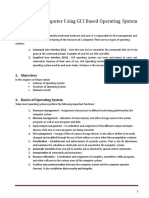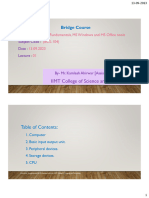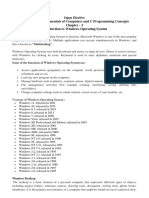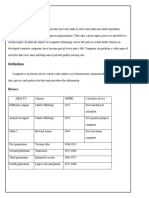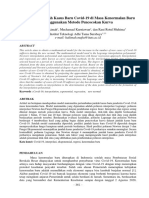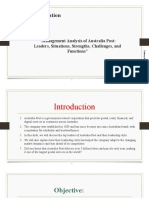Explain The Various Components of Windows Desktop
Uploaded by
Amisha VermaExplain The Various Components of Windows Desktop
Uploaded by
Amisha Verma1. Explain the various components of windows desktop.
Windows is an essential part of a Computer. It’s the most commonly used
Operating System all around the world both individually and commercially.
Windows consists of the following components:
• Desktop: The desktop is the very first screen we see after windows start.
Here, we can see folders like My Computer, Documents, etc. It is the main
working area of many of your computer operations. You keep your special
files on the desktop so you can access them easily and it gives access to
other important functionalities as well such as search bar, taskbar, and file
explorer.
• Taskbar: The taskbar is a simple row at the very bottom of the screen
where all currently opened files or applications are listed. It helps you select
what you want to keep opened and what you want to close. In more recent
versions of operating systems, users can also pin programs or files so that they
can be accessed quickly, often with a single click.
• Start Menu: By clicking the start menu, in the bottom left corner of the
screen, a vertical window consisting of the recently opened applications and
saved locations will pop-up. You can select and run any application/file from
here .
• Maximize/Minimize/Close Buttons: These buttons are located at the top
right corner of our opened documents, and the area used to close, minimize
or maximize the document window. They help us jump from one task to
another fast and let us decide either we want to close an application or
resize its area on the screen or just hide it for a few moments.
• My Computer: When we double click on My Computer, we find ourselves
looking at a window where we can navigate between Computer Drives and
Control Panel tools. It also gives us access to different drives on our
computer and the data which lies in those drives.
• Recycle Bin: When we delete a file or folder, it goes into the Recycle Bin
from where it can either be restored or permanently deleted from the
Computer. Once, a file or folder is deleted from the Recycle Bin, it is very
difficult to recover it again. Therefore, the utility of the recycle bin is very
essential to use properly if you deal with important documents and files on a
day to day basis.
• Shortcut: A shortcut is a button or icon which typically is located on the
Desktop. By clicking on this Shortcut, We can quickly open the document or
application of which it is a shortcut. It helps us save the tedious task of
going to the main directory again and again and saves our time.
• Mouse Functions: The mouse is an input device which is essential in the
working of a computer. It performs several important functions on Windows
like Scrolling, Right and Left Clicks, etc. It performs another very important
function of modern windows which is pointing towards different things and
giving special instructions whenever needed.
• Copy/Cut/Paste: These options are one of the most essential components
of Windows. The copy is used to copy a portion of a document from one
document to another or a file or folder from one location to another. The
paste is used to paste the copied item on the desired location. While Cut is
used to move an item to our desired location in the Computer.
• Toolbar: The toolbar is a simple row where we can see different options to
customize the look of our opened window. It has two types, Formatting
Toolbar, and Standard Toolbar. The standard toolbar consists of options like
new documents, save a document, etc. While Formatting Toolbar consists of
options like font size, font type, etc.
• Icons: An icon is a small graphical representation of a program or file. When
you double-click an icon, the associated file or program will be opened. It is
generally located in the lower left corner of the desktop.
• Notification area: It shows the notification icons, the current date and time and
lets you set the clock. Also known as the system tray and it is generally located in
the lower right corner of the desktop.
2. Write short notes on following:-
a) Control Panel:
The Control Panel is a section of Microsoft Windows that enables a user
to change various computer hardware and software features. Settings
for the mouse, display, sound, network, and keyboard represent a few
examples of what may be modified in the Control Panel.
The control panel, in the context of Windows, is a software module used
to perform administrative and management operating system tasks and
provide access to specific software features.
The control panel is used to configure and manage almost all aspects of
Windows, including keyboard and mouse functionality, users and
passwords, power options, network settings, desktop background,
display settings, sound settings, mouse settings, hardware and software
options, installation and removal of programs, parental control, speech
recognition, etc.
b) Taskbar:
The taskbar is a movable, concealable icon bar that is set on the very
edge of the graphical user interface (GUI) desktop and serves as a
launching pad for applications as well as a holder for icons indicating
running programs.The taskbar’s default position is at the bottom of the
screen; but it can be repositioned to the left, right and top portions of
the desktop. It may be locked in place, set to auto-hide or kept on top of
other windows. Using the taskbar, a running program can easily be made
current (i.e. made usable) when many programs are running
simultaneously. Icons in the taskbar that represent running applications
also serve as toggle buttons that allow switching windows for running
applications between the minimized state and the maximized or resized
state.
c) Icons:
An icon is a small graphical representation of a program or file. When
you double-click an icon, the associated file or program will be opened.
For example, if you were to double-click on the My Computer icon, it
would open Windows Explorer. Icons are a component of GUI operating
systems, including Apple macOS X and Microsoft Windows. Icons help
users quickly identify the type of file represented by the icon.
d) Notepad:
Notepad is a generic text editor included with all versions
of Microsoft Windows that allows you to create, open, and
read plaintext files. If the file contains special formatting or is not a
plaintext file, it cannot be read in Notepad. The resulting files—typically
saved with the .txt extension—have no format tags or styles, making the
program suitable for editing system files that are to be used in a DOS
environment. Notepad supports both left to right and right to left based
languages and one can alternate between these weaving formats by
using the right or left ctrl + shift keys to go to right to left format or left
to right format respectively.
e) Paint brush:
A paintbrush is a tool found in image editing and paint programs that
allows users to digitally paint on an image file. This feature enables users
to make edits to an image, like giving a picture a mustache or create
something new on a blank page. The program opens and saves files
in Windows bitmap (BMP), JPEG, GIF, PNG, and single-page TIFF formats.
For its simplicity and that it is included with Windows, it rapidly became
one of the most used applications in the early versions of Windows,
introducing many to painting on a computer for the first time. It is still
widely used for simple image manipulation tasks.
3. Write short on windows Operating System Environment.
Microsoft Windows is an operating system created by Microsoft for PC
computers. An operating system is the software utilized to run and manage
programs and functions on the computer. Windows updates and adds to its
features with each release, however some of the features it is known for are
Windows Live, Windows Search, Windows Updates and Windows Taskbar.
Control Panel:- The Control Panel is a section of Microsoft Windows that
enables a user to change various computer hardware and software
features. Settings for the mouse, display, sound, network,
and keyboard represent a few examples of what may be modified in the
Control Panel. Below are some examples of how the Control Panel
appeared in Windows.
Taskbar:- The taskbar is an element of an operating system located at the
bottom of the screen. It allows you to locate and launch programs
through Start and the Start menu, or view any program that is currently
open. The taskbar first introduced with Microsoft Windows 95 and can be
found in all subsequent versions of Windows. It also allows them to check
the date and time, items running in the background through
the Notification Area, and with early versions of Windows access to
the Quick Launch.
Desktop :- A desktop is a term commonly used to describe a desktop
computer or system unit. When referring to an operating system
or GUI (graphical user interface), the desktop is a system of organization of
icons on a screen. The Microsoft Windows desktop was first introduced
with Microsoft Windows 95 and included with every version of Windows
since then.
Windows Application :- Windows Application is a user build an application
that can run on a Windows platform. The windows application has a
graphical user interface that is provided by Windows Forms. Windows
forms provide a variety of controls including Button, TextBox, Radio Button,
CheckBox, and other data and connection controls. You can easily design a
web application using an IDE Microsoft Visual Studio using a variety of
languages including Visual Basic, C++ and many more
Icons :- An icon is a small graphical representation of a program or file.
When you double-click an icon, the associated file or program will be
opened. For example, if you were to double-click on the My Computer icon,
it would open Windows Explorer. Icons are a component of GUI operating
systems, including Apple macOS X and Microsoft Windows. Icons help users
quickly identify the type of file represented by the icon. The image to the
right is an example of “My Computer” icons in different versions of
Microsoft Windows.
Calculator :- Calculator is a calculating application included in all the
versions of Windows. It can be used to perform simple calculation,
scientific calculation and Programming calculation.
Notepad :- Notepad is a generic text editor included with all versions of
Microsoft Windows that allows you to create, open, and read plaintext
files. If the file contains special formatting or is not a plaintext file, it will
not be able to be read in Microsoft Notepad.
Paintbrush :- Paintbrush is a raster image editor for Mac OS X. It aims to
replace MacPaint, an image editor for the classic Mac OS last released in
1988. It also is an alternative to MS Paint. It has basic raster image editing
capabilities and a simple interface designed for ease of use. It exports
as PNG, JPG, BMP, GIF, and TIFF. The application also is often used for pixel
art because of its grid option, and is not made for large scale images
or GIMP or Photoshop-like editing on pictures or photographs.
4. Write short notes on :-
a) Accessories & Taskbar
Accessories:-
Windows operating system ships with some handy applications known as
Windows accessories. Calculator, Notepad, Paint, Explorer, WordPad are
some of the most frequently used accessories. The accessories are as given
below-
Calculator :- Calculator is a calculating application included in all the
versions of Windows. It can be used to perform simple calculation, scientific
calculation and Programming calculation.
Notepad :- Notepad is a generic text editor included with all versions
of Microsoft Windows that allows you to create, open, and read plaintext files.
If the file contains special formatting or is not a plaintext file, it will not be able
to be read in Microsoft Notepad. The image to the right is a small example of
what the Microsoft Notepad may look like while running.
Snipping Tool :- Snipping Tool is another useful of Windows accessories
included in Windows 7, Windows Vista, and Experience Pack for Windows XP
Tablet PC Edition 2005. It was originally released as a powertoy for the Tablet
PC. The program is a screen-capture tool that allows taking screenshots
(called snips) of an open window, rectangular areas, a free-form area, or the
entire screen. Snips can then be annotated using a mouse or a tablet, saved
as an image file (PNG, GIF, or JPEG file) or an HTML page, or e-mailed. The
Snipping Tool captures all or part of the computer display screen as a picture.
You can save the picture and attach it to an e-mail or paste the picture into a
document. Snipping tool can be used to Print Screen, annotate and use in
other applications.
Paint:- Paint (formerly Paintbrush for Windows) is a simple graphics painting
program that has been included with all versions of Microsoft Windows. It is
often referred to as MS Paint or Microsoft Paint. The program opens and
saves files as Windows bitmap (24-bit, 256 color, 16 color, and monochrome)
.BMP, JPEG, GIF. Paintbrush supports GIF without animation or transparency.
It rapidly became one of the most used applications in the early versions of
Windows—introducing many to painting on a computer for the first time—
and still has strong associations with the immediate usability of the old
Windows workspace.
Character Map :- Character Map is a utility included with Microsoft Windows
operating systems and is used to view the characters in any installed font, to
check what keyboard input (Alt code) is used to enter those characters, and
to copy characters to the clipboard in lieu of typing them. The tool is usually
useful for entering special characters.
Notepad :- Notepad is a common text-only (plain text) editor. The resulting
files—typically saved with the .txt extension—have no format tags or styles,
making the program suitable for editing system files that are to be used in a
DOS environment. Notepad supports both left-to-right and right-to-left based
languages, and one can alternate between these viewing formats by using
the right or left Ctrl+Shift keys to go to right-to-left format or left-to-right
format, respectively.
WordPad :- Microsoft WordPad is a free rich text editor included with
Microsoft Windows 95 and the later. WordPad can format and print text, but
lacks intermediate features such as a spell checker, thesaurus, and support
for tables. As such, it is suitable for writing letters or short pieces, but
underpowered for work that relies heavily on graphics or typesetting.
System Tools :- For a smooth performance of a system, periodic maintenance
is necessary. Tools like Disk Check, Disk Derangement, etc., helps in system
maintenance. Windows includes some of the system utilities such as Disk
Cleanup, Disk Defragment, System Restore, Control Panel and so on.
Taskbar :-
A taskbar is an element of a graphical user interface which has various
purposes. It typically shows which programs are currently running.
The specific design and layout of the taskbar varies between individual
operating systems, but generally assumes the form of a long strip along one
edge of the screen. On this strip are various icons which correspond to the
windows open within a program. Clicking these icons allow the user to easily
switch between programs or windows, with the currently active program or
window usually appearing differently from the rest. In more recent versions of
operating systems, users can also "pin" programs or files so that they can be
accessed quickly, often with a single click. On the right side of the taskbar is
the Notification Area that allows you to check the date and time, items
running in the background. The taskbar was first introduced with
Microsoft Windows 95 and is found in all subsequent versions of Windows.
b) Control Panel & Desktop
Control Panel:-
The Control Panel is a feature of the Windows operating system that
allows the user to modify system settings and controls. It includes
several small applications, or control panels, that can be used to view
and change hardware or software settings. Some examples of hardware
control panels are Display, Keyboard and Mouse settings. Software
control panels include Date and Time, Power Options, Fonts and
Administrative Tools. Many control panels are included as part of the
Windows operating system, but others can be installed by third-party
applications or utilities. For example, if you add a new mouse to your
computer, it may come with a CD for installing a control panel specific
for that mouse. Some graphics cards may also install an additional
control panel that gives the user greater control over the computer's
visual settings. Regardless of when control panels are installed, they can
always be found within the Control Panel folder.
Desktop:-
The desktop is the main screen area that you see after you turn on your
computer and log on to Windows. Like the top of an actual desk, it
serves as a surface for your work. When you open programs or folders,
they appear on the desktop. You can also put things on the desktop,
such as files and folders, and arrange them however you want. The
desktop is sometimes defined more broadly to include the taskbar and
Windows Sidebar. The taskbar sits at the bottom of your screen. It shows
you which programs are running and allows you to switch between
them. It also contains the Start button , which you can use to access
programs, folders, and computer settings. On the side of the screen,
Sidebar contains small programs called gadgets.
You might also like
- Vdocuments - MX - Caterpillar d3c Series II Manual XL Series III Track Type Tractor d8r Series50% (4)Vdocuments - MX - Caterpillar d3c Series II Manual XL Series III Track Type Tractor d8r Series4 pages
- Class - 6 Lesson - 4 More On MS Word 2010 Short Answer Type Questions83% (6)Class - 6 Lesson - 4 More On MS Word 2010 Short Answer Type Questions2 pages
- Chapter: 1.4 Basic Internet Terminology Topic: 1.4.1 Basic Internet TerminologyNo ratings yetChapter: 1.4 Basic Internet Terminology Topic: 1.4.1 Basic Internet Terminology3 pages
- Types of Software: A. Multiple Choice QuestionsNo ratings yetTypes of Software: A. Multiple Choice Questions6 pages
- Shri Krishan Institute of Education Ms-Paint100% (1)Shri Krishan Institute of Education Ms-Paint10 pages
- Iso 13679 Connection Testing: Test DatasheetNo ratings yetIso 13679 Connection Testing: Test Datasheet2 pages
- Class 7 Extra Computer Science CHAPTER 3 (Computer Viruses)100% (1)Class 7 Extra Computer Science CHAPTER 3 (Computer Viruses)3 pages
- Computer History and Generations Questions Papers With AnswersNo ratings yetComputer History and Generations Questions Papers With Answers14 pages
- Computer Education Class 7: Unit # 01 Hardware Basics100% (1)Computer Education Class 7: Unit # 01 Hardware Basics4 pages
- Chapter 5 Advanced Features of Excel PDFNo ratings yetChapter 5 Advanced Features of Excel PDF3 pages
- Computer Fundamental & Office Automation (BCA-102)No ratings yetComputer Fundamental & Office Automation (BCA-102)209 pages
- Operating Computer Using Gui Based Operating System100% (1)Operating Computer Using Gui Based Operating System5 pages
- Class Vi-Worksheet Chapter-3 (Introduction To Operating System)50% (2)Class Vi-Worksheet Chapter-3 (Introduction To Operating System)2 pages
- Classification of Computers According To Technology and Size90% (20)Classification of Computers According To Technology and Size12 pages
- Introduction To The Windows 10 Desktop, Teacher's Lesson PlanNo ratings yetIntroduction To The Windows 10 Desktop, Teacher's Lesson Plan2 pages
- Bridge Course 1 For Computer FundamentalsNo ratings yetBridge Course 1 For Computer Fundamentals7 pages
- Question Bank 1 Introduction To Computer: Q.1 Fill in The Blanks100% (1)Question Bank 1 Introduction To Computer: Q.1 Fill in The Blanks32 pages
- E. JONES - Violin Star Book 1 (With Violin Duos)100% (1)E. JONES - Violin Star Book 1 (With Violin Duos)71 pages
- PSI 8.1LT_116kWe_HD_SchedaTecnica_DatasheetNo ratings yetPSI 8.1LT_116kWe_HD_SchedaTecnica_Datasheet4 pages
- Marketing and Sales Strategy For SunSplash ParkbjvccvvvNo ratings yetMarketing and Sales Strategy For SunSplash Parkbjvccvvv3 pages
- The Future of Reading Electronic Books Ebooks Reading Comprehension Exercises 5696No ratings yetThe Future of Reading Electronic Books Ebooks Reading Comprehension Exercises 56961 page
- October 2009: in Case of Doubt, The German-Language Original Shall Be Considered Authoritative100% (1)October 2009: in Case of Doubt, The German-Language Original Shall Be Considered Authoritative15 pages
- Acoustic Tractor Beam: 35 Steps (With Pictures) PDFNo ratings yetAcoustic Tractor Beam: 35 Steps (With Pictures) PDF38 pages


